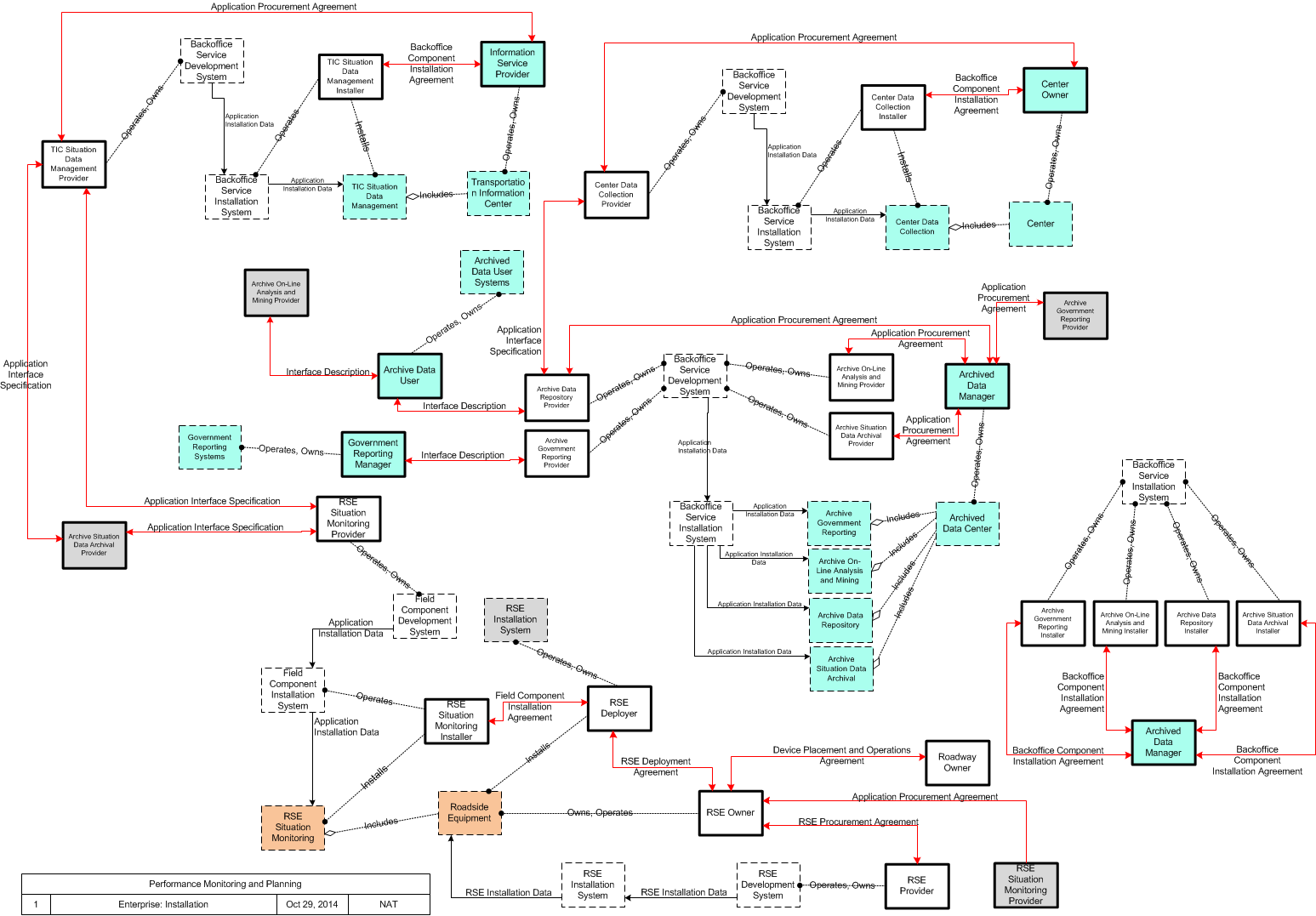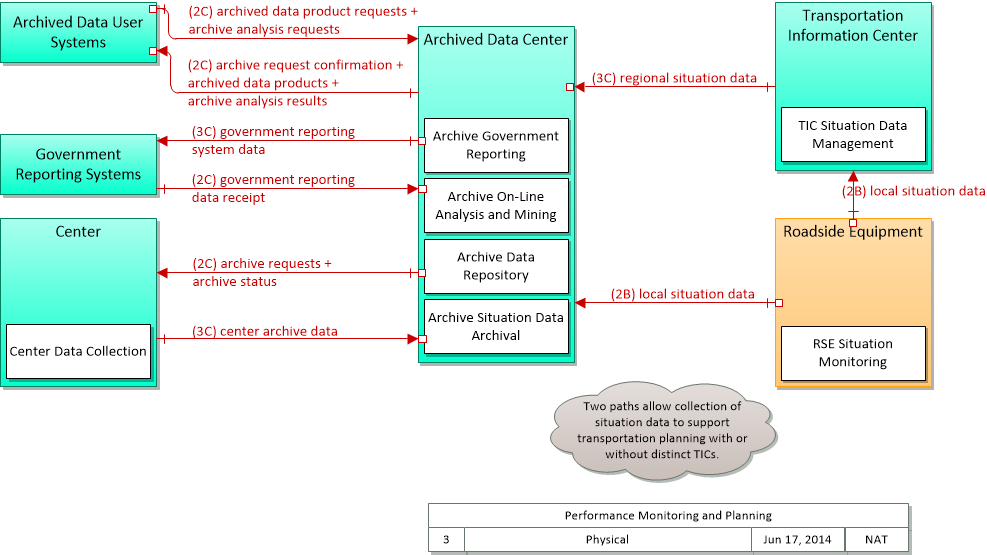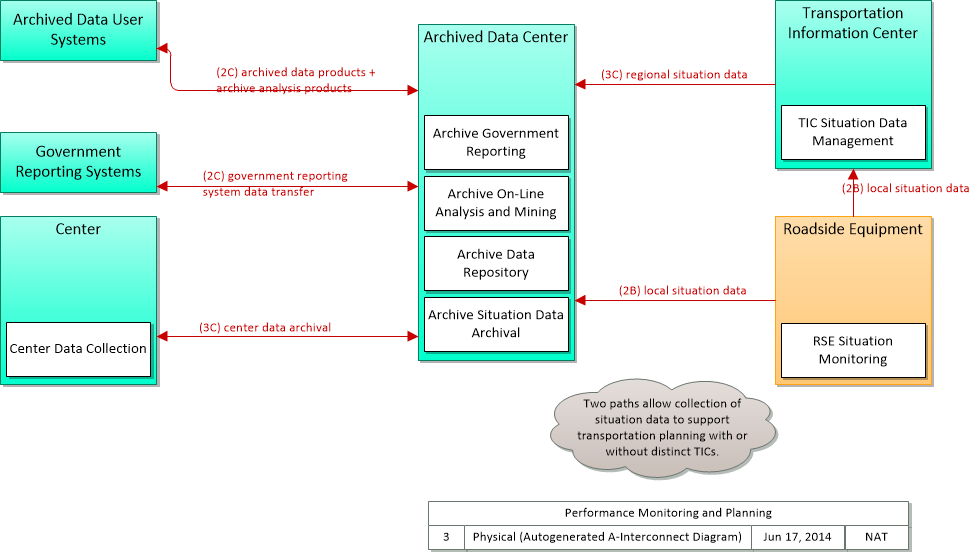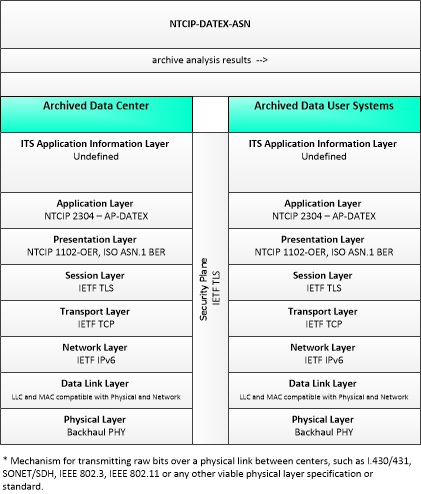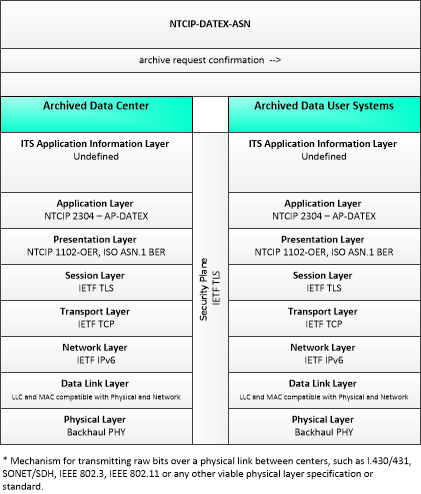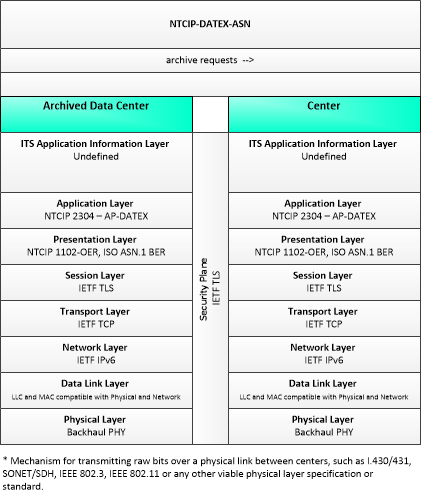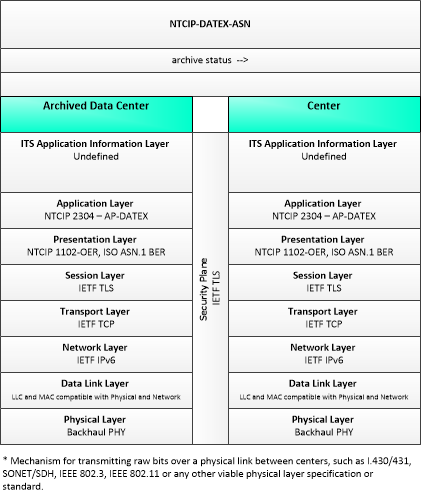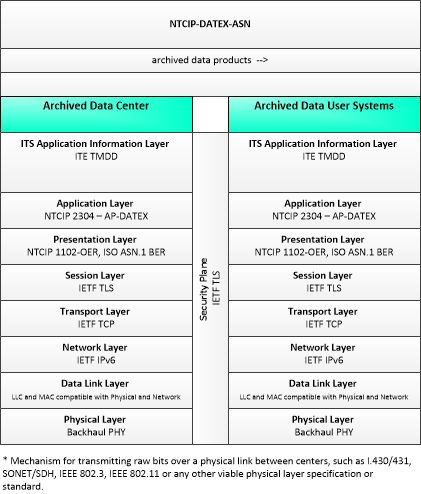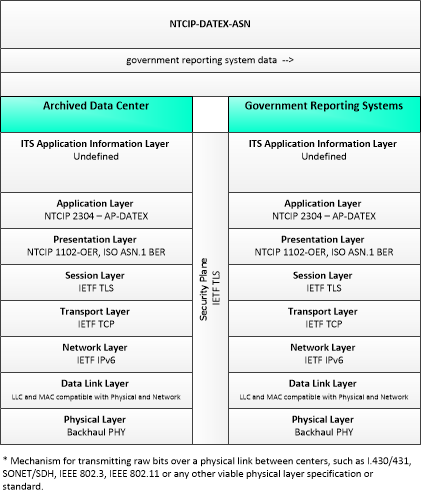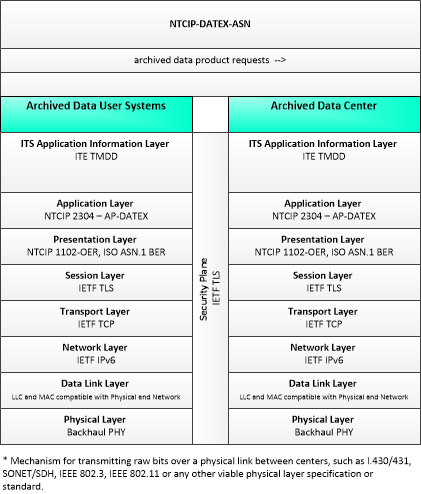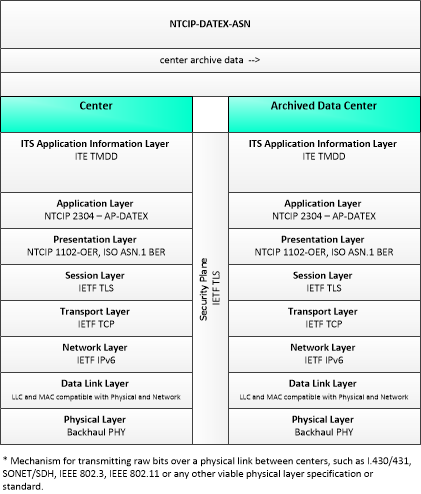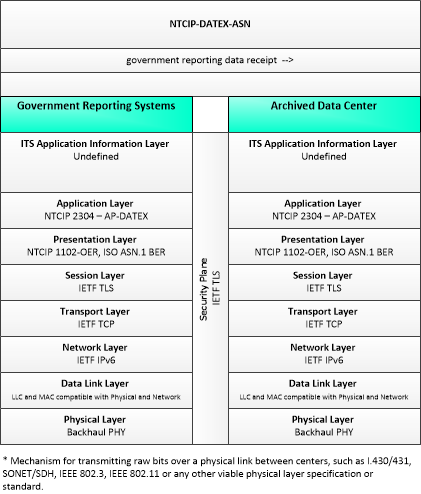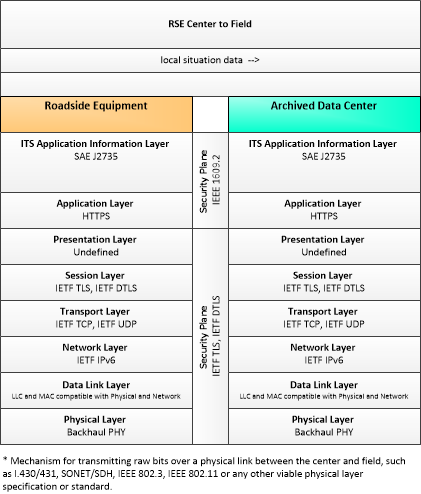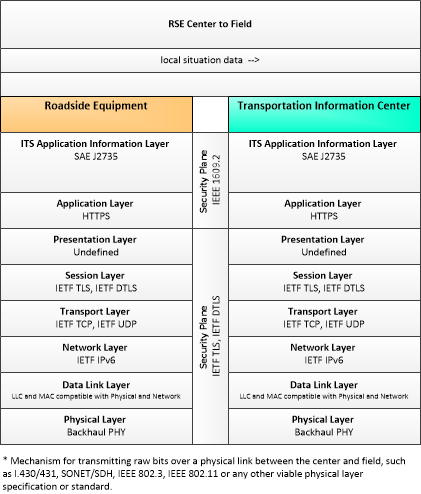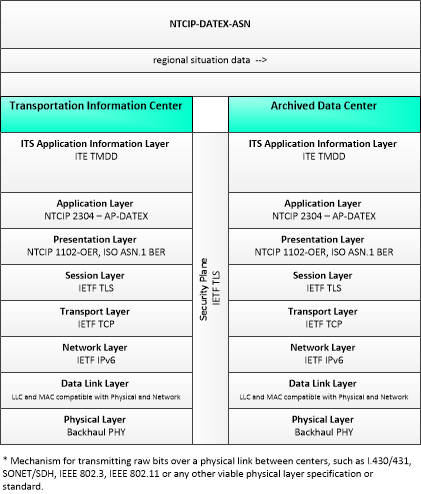This is one way this application may be realized, but not the only way. There are other ways to build a given application and accomplish a stated objective.
The enterprise diagram can be viewed in SVG or PNG format and the current format is
.
| Enterprise Object |
Description |
| Application Certification Entity |
The body that determines whether an application may be deployed and operated in the Connected Vehicle Environment. This entity's composition, the requirements it applies and the procedures it uses to verify those requirements may vary with application type. For example, applications with human safety component (crash avoidance, movement assistance etc.) may have stringent requirements and extensive testing in a variety of conditions, while applications that provide strictly mobility functionality may have far less testing requirements; possibly as little as just making sure the application doesn't interfere with any other applications. |
| Archive Data Repository Installer |
Application Component Installers are specified more by role than by function. Installers are responsible for the installation of the application component, which may require a support system, and may entail agreements and relationships between end users and application providers. |
| Archive Data Repository Maintainer |
Application Component Maintainers are specified more by role than by function. Maintainers are responsible for the maintenance (configuration changes, patches and updates, hardware repairs) of the application component, which may require a support system, and may entail agreements and relationships between end users and application providers. |
| Archive Data Repository Provider |
Application Component Providers are specified more by role than by function. Providers are responsible for the development of the application component, including initial creation, enhancement and bug fixes. Delivery of the application to the end user may require relationships with other entities (installers, maintainers) if the provider chooses not to fulfill those roles. |
| Archive Data User |
Any user of an archive data system in the ITS environment (planners, researchers, operators, analysts etc.) |
| Archive Government Reporting Installer |
Application Component Installers are specified more by role than by function. Installers are responsible for the installation of the application component, which may require a support system, and may entail agreements and relationships between end users and application providers. |
| Archive Government Reporting Maintainer |
Application Component Maintainers are specified more by role than by function. Maintainers are responsible for the maintenance (configuration changes, patches and updates, hardware repairs) of the application component, which may require a support system, and may entail agreements and relationships between end users and application providers. |
| Archive Government Reporting Provider |
Application Component Providers are specified more by role than by function. Providers are responsible for the development of the application component, including initial creation, enhancement and bug fixes. Delivery of the application to the end user may require relationships with other entities (installers, maintainers) if the provider chooses not to fulfill those roles. |
| Archive On-Line Analysis and Mining Installer |
Application Component Installers are specified more by role than by function. Installers are responsible for the installation of the application component, which may require a support system, and may entail agreements and relationships between end users and application providers. |
| Archive On-Line Analysis and Mining Maintainer |
Application Component Maintainers are specified more by role than by function. Maintainers are responsible for the maintenance (configuration changes, patches and updates, hardware repairs) of the application component, which may require a support system, and may entail agreements and relationships between end users and application providers. |
| Archive On-Line Analysis and Mining Provider |
Application Component Providers are specified more by role than by function. Providers are responsible for the development of the application component, including initial creation, enhancement and bug fixes. Delivery of the application to the end user may require relationships with other entities (installers, maintainers) if the provider chooses not to fulfill those roles. |
| Archive Situation Data Archival Installer |
Application Component Installers are specified more by role than by function. Installers are responsible for the installation of the application component, which may require a support system, and may entail agreements and relationships between end users and application providers. |
| Archive Situation Data Archival Maintainer |
Application Component Maintainers are specified more by role than by function. Maintainers are responsible for the maintenance (configuration changes, patches and updates, hardware repairs) of the application component, which may require a support system, and may entail agreements and relationships between end users and application providers. |
| Archive Situation Data Archival Provider |
Application Component Providers are specified more by role than by function. Providers are responsible for the development of the application component, including initial creation, enhancement and bug fixes. Delivery of the application to the end user may require relationships with other entities (installers, maintainers) if the provider chooses not to fulfill those roles. |
| Archived Data Manager |
The entity that owns and operates archived data management facilities. |
| Center Data Collection Installer |
Application Component Installers are specified more by role than by function. Installers are responsible for the installation of the application component, which may require a support system, and may entail agreements and relationships between end users and application providers. |
| Center Data Collection Maintainer |
Application Component Maintainers are specified more by role than by function. Maintainers are responsible for the maintenance (configuration changes, patches and updates, hardware repairs) of the application component, which may require a support system, and may entail agreements and relationships between end users and application providers. |
| Center Data Collection Provider |
Application Component Providers are specified more by role than by function. Providers are responsible for the development of the application component, including initial creation, enhancement and bug fixes. Delivery of the application to the end user may require relationships with other entities (installers, maintainers) if the provider chooses not to fulfill those roles. |
| Center Owner |
General representation of the owner of the general "Center" physical object. |
| Device Certification Entity |
The body that determines whether a device may be deployed and operated in the Connected Vehicle Environment. This entity's composition, the requirements it applies and the procedures it uses to verify those requirements may vary with device type. |
| Federal Regulatory |
Federal regulatory bodies that have legal authority to control and/or provide input to policies regulating transportation infrastructure and operations. This includes entities such as the Federal Communications Commission and US Department of Transportation. |
| Government Reporting Manager |
The entity charged with reporting ITS data as per federal reporting requirements. |
| Information Service Provider |
The "Information Service Provider" represents the owner of the Transportation Information Center. The Information Service Provider is responsible for collecting and disseminating information relevant to the traveling public. |
| Roadway Owner |
The owner of the roadway proximate to which roadside equipment will be/is installed. |
| RSE Deployer |
The entity responsible for the deployment, operations and maintenance of roadside equipment. |
| RSE Operator |
The entity that operates roadside equipment in the transportation environment. |
| RSE Owner |
The owner of roadside equipment. |
| RSE Provider |
The "RSE Provider" is the entity that develops and (presumably) sells roadside equipment to other entities for deployment and research. |
| RSE Situation Monitoring Installer |
Application Component Installers are specified more by role than by function. Installers are responsible for the installation of the application component, which may require a support system, and may entail agreements and relationships between end users and application providers. |
| RSE Situation Monitoring Maintainer |
Application Component Maintainers are specified more by role than by function. Maintainers are responsible for the maintenance (configuration changes, patches and updates, hardware repairs) of the application component, which may require a support system, and may entail agreements and relationships between end users and application providers. |
| RSE Situation Monitoring Provider |
Application Component Providers are specified more by role than by function. Providers are responsible for the development of the application component, including initial creation, enhancement and bug fixes. Delivery of the application to the end user may require relationships with other entities (installers, maintainers) if the provider chooses not to fulfill those roles. |
| State Regulatory |
State regulatory bodies that have legal authority to control and/or provide input to policies regulating vehicles, transportation infrastructure and operations. This includes entities like Departments of Motor Vehicles, property tax authorities and tolling agencies. |
| TIC Situation Data Management Installer |
Application Component Installers are specified more by role than by function. Installers are responsible for the installation of the application component, which may require a support system, and may entail agreements and relationships between end users and application providers. |
| TIC Situation Data Management Maintainer |
Application Component Maintainers are specified more by role than by function. Maintainers are responsible for the maintenance (configuration changes, patches and updates, hardware repairs) of the application component, which may require a support system, and may entail agreements and relationships between end users and application providers. |
| TIC Situation Data Management Provider |
Application Component Providers are specified more by role than by function. Providers are responsible for the development of the application component, including initial creation, enhancement and bug fixes. Delivery of the application to the end user may require relationships with other entities (installers, maintainers) if the provider chooses not to fulfill those roles. |
| Resource |
Description |
| Application Component Certification Requirements |
The requirements that define the functionality, performance and operational environment of an application component. Certification Requirements must be met in order for an application to be installed in the CVE. |
| Archive Data Repository |
"Archive Data Repository" collects data and data catalogs from one or more data sources and stores the data in a focused repository that is suited to a particular set of ITS data users. It includes capabilities for performing quality checks on the incoming data, error notification, and archive to archive coordination. It supports a broad range of implementations, ranging from simple data marts that collect a focused set of data and serve a particular user community to large-scale data warehouses that collect, integrate, and summarize transportation data from multiple sources and serve a broad array of users within a region. |
| Archive Government Reporting |
"Archive Government Reporting" selects and formats data residing in an ITS archive to facilitate local, state, and federal government data reporting requirements. |
| Archive On-Line Analysis and Mining |
"Archive On-Line Analysis and Mining" provides advanced data analysis, summarization, and mining features that facilitate discovery of information, patterns, and correlations in large data sets. Multidimensional analysis, selective summarization and expansion of data details, and many other advanced analysis services may be offered. |
| Archive Situation Data Archival |
"Archive Situation Data Archival" collects and archives traffic, roadway, and environmental information for use in off-line planning, research, and analysis. It controls and collects information directly from equipment at the roadside, reflecting the deployment of traffic detectors that are used primarily for traffic monitoring and planning purposes rather than for traffic management. |
| Archived Data Center |
The 'Archived Data Center' collects, archives, manages, and distributes data generated from ITS sources for use in transportation administration, policy evaluation, safety, planning, performance monitoring, program assessment, operations, and research applications. The data received is formatted and tagged with attributes that define the data source, conditions under which it was collected, data transformations, and other information (i.e. meta data) necessary to interpret the data. The archive can fuse ITS generated data with data from non-ITS sources and other archives to generate information products utilizing data from multiple functional areas, modes, and jurisdictions. The archive prepares data products that can serve as inputs to federal, state, and local data reporting systems. The 'Archived Data Center' may reside within an operational center and provide focused access to a particular agency's data archives. Alternatively, it may operate as a distinct center that collects data from multiple agencies and sources and provides a general data warehouse service. |
| Archived Data User Systems |
'Archived Data User Systems' represents the systems users employ to access archived data. The general interface provided allows a broad range of users (e.g. planners, researchers, analysts, operators) and their systems (e.g. databases, models, analytical tools, user interface devices) to acquire data and analyses results from the archive. |
| Backoffice Service Development System |
The systems used to develop backoffice (center) hardware and software components of applications. |
| Backoffice Service Installation System |
The systems used to install and configure backoffice (center) hardware and software components. |
| Backoffice Service Maintenance System |
The systems used to maintain and upgrade backoffice (center) hardware and software components. |
| Center |
This general physical object is used to model core capabilities that are common to any center. |
| Center Data Collection |
"Center Data Collection" collects and stores information that is created in the course of center operations. This data can be used directly by operations personnel or it can be made available to other data users and archives in the region. |
| Device Certification Requirements |
The requirements that define the functionality, performance and operational environment of a connected vehicle device. Certification Requirements must be met in order for the device to be granted the credentials necessary to operate in the Connected Vehicle Environment. |
| Field Component Development System |
The system used in a backoffice environment to develop and test the field component of the application. |
| Field Component Installation System |
The system used to install a field component of a connected vehicle application. |
| Field Component Maintenance System |
The system used to install and configure changes and updates to the field component of the application. This system is capable of acquiring and reporting diagnostic information about the application's configuration and performance. |
| Government Reporting Systems |
'Government Reporting Systems' represents the system and associated personnel that prepare the inputs to support the various local, state, and federal government transportation data reporting requirements (e.g. Highway Performance Monitoring System, Fatality Analysis Reporting System) using data collected by ITS systems. It represents a system interface that provides access to the archived data relevant to these reports. In most cases, this system will combine data collected from ITS archives with data from non-ITS sources to assemble the required information. |
| Roadside Equipment |
'Roadside Equipment' (RSE) represents the Connected Vehicle roadside devices that are used to send messages to, and receive messages from, nearby vehicles using Dedicated Short Range Communications (DSRC) or other alternative wireless communications technologies. Communications with adjacent field equipment and back office centers that monitor and control the RSE are also supported. This device operates from a fixed position and may be permanently deployed or a portable device that is located temporarily in the vicinity of a traffic incident, road construction, or a special event. It includes a processor, data storage, and communications capabilities that support secure communications with passing vehicles, other field equipment, and centers. |
| RSE Development System |
The system used in a backoffice environment to develop and test the roadside equipment. |
| RSE Installation System |
The system used to install and configure the roadside equipment. |
| RSE Maintenance System |
The system used to configure changes and updates to the roadside equipment. This system is capable of acquiring and reporting diagnostic information about the RSE's configuration and performance. |
| RSE Situation Monitoring |
"RSE Situation Monitoring" is a general application object that supports collection of traffic, environmental, and emissions data from passing vehicles. The data is collected, filtered, and forwarded based on parameters provided by the back office. Parameters are provided to passing vehicles that are equipped to collect and send situation data to the infrastructure in snapshots. In addition, this object collects current status information from local field devices including intersection status, sensor data, and signage data, providing complete, configurable monitoring of the situation for the local transportation system in the vicinity of the RSE. |
| TIC Situation Data Management |
"TIC Situation Data Management" manages connected vehicle situation data collection, quality controls, filtering, aggregation, and storage. Through this process, raw data reported by connected vehicles are transformed into information products that can be accessed and used to support transportation operations and traveler information. The distribution of the connected vehicle-derived information products is handled by other application objects. |
| Transportation Information Center |
The 'Transportation Information Center' collects, processes, stores, and disseminates transportation information to system operators and the traveling public. The physical object can play several different roles in an integrated ITS. In one role, the TIC provides a data collection, fusing, and repackaging function, collecting information from transportation system operators and redistributing this information to other system operators in the region and other TICs. In this information redistribution role, the TIC provides a bridge between the various transportation systems that produce the information and the other TICs and their subscribers that use the information. The second role of a TIC is focused on delivery of traveler information to subscribers and the public at large. Information provided includes basic advisories, traffic and road conditions, transit schedule information, yellow pages information, ride matching information, and parking information. The TIC is commonly implemented as a website or a web-based application service, but it represents any traveler information distribution service. |
| Role |
Description |
| Certifies |
An Enterprise verifies that a target Resource meets relevant performance, functional, environmental and quality requirements. |
| Constrains |
A Resource or Enterprise applies requirements, constraints and associated tests to another Resource. |
| Installs |
An Enterprise performs the initial delivery, integration and configuration of the target Resource. |
| Maintains |
An Enterprise administers the hardware and software that comprise the target Resource. |
| Member |
An Enterprise is part of another larger, target Enterprise. |
| Operates |
An Enterprise controls the functionality and state of the target Resource. An Enterprise that Operates a resource is considered Responsible. |
| Owns |
An Enterprise has financial ownership and control over the Resource. An Enterprise that Owns a resource is considered Accountable. |
| Coordination |
Type |
Description |
| Application Installation Data |
Information Sharing |
Data needed to install the application, including the application executable code and any configuration data. Unidirectional flow. |
| Application Interface Specification |
Agreement |
The definition of an interface between two application components that operate on two distinct pieces of hardware. The Application Interface Specification is specific to the application in question. |
| Application Maintenance Data |
Information Sharing |
Data used to facilitate the upgrade, patching and general health maintenance of an application component. |
| Application Performance Data |
Information Sharing |
Data used to characterize application performance, including such measures as availability, known errors and known uses. |
| Application Procurement Agreement |
Agreement |
An agreement whereupon one entity provides a copy of an application component to another entity. This component is capable of being installed and functioning, according to its requirements that passed through the application's certification process. |
| Application Usage Agreement |
Agreement |
An agreement in which one entity that controls an application component's use gives the other entity the necessary tools and permission to operate that application or application component. |
| Backoffice Component Installation Agreement |
Agreement |
An agreement that grants one party permission to install a backoffice application component on a center-based device controlled by the other party. |
| Backoffice Component Maintenance Agreement |
Agreement |
An agreement in which one entity maintains the operational status of the backoffice component of an application under the control of another entity. This maintenance may include routine and as-needed maintenance, such as software update and configuration, hardware replacement and related system administration activities. |
| Device Placement and Operations Agreement |
Agreement |
An agreement that enables the controller of a physical device to install it (so as to make it operational) at a fixed location controlled by another entity. |
| Expectation of Data Provision |
Expectation |
An expectation where one party believes another party will provide data on a regular and recurring basis, and that that data will be useful to the receiver in the context of the receiver's application. This thus includes some expectation of data fields, timeliness, quality, precision and similar qualities of data. |
| Field Component Installation Agreement |
Agreement |
An agreement that grants one party permission to install a field application component on a roadside device controlled by the other party. |
| Field Component Maintenance Agreement |
Agreement |
An agreement in which one entity maintains the operational status of the field component of an application under the control of another entity. This maintenance may include routine and as-needed maintenance, such as software update and configuration, hardware replacement and related system administration activities. |
| Includes |
Includes |
Indicates that one component is entirely contained within another component. |
| Information Exchange and Action Agreement |
Agreement |
An agreement to exchange information, which may include data or control information; the exact information to be exchanged may vary from agreement to agreement. This also includes a specification for action that shall, should or may be taken by one party in response to this information. |
| Interface Description |
Agreement |
Documentation of the interface between two systems, where one system does not have an application component that is part of the application, but does provide and/or receive data and/or information that is used by or sourced from the application. In many cases this is an existing interface used by the application, so the description of the interface already exists and is imposed by the terminator. |
| Maintenance Data Exchange Agreement |
Agreement |
An agreement that states one entity will provide data related to maintenance of an application component to the other entity. |
| Operations Agreement |
Agreement |
An agreement where one entity agrees to operate a device or application on behalf of another, device/application controlling entity. |
| RSE Deployment Agreement |
Agreement |
Agreement to install, configure and make operational roadside equipment, between the provider of that equipment and the entity that controls access to the roadside. May define locations, expectation of power provision, backhaul responsibility and installation restrictions. |
| RSE Installation Data |
Information Sharing |
Data necessary to configure and make RSE operational. Uni-directional. |
| RSE Maintenance Data |
Information Sharing |
Data necessary to modify the operational configuration of RSE; assumes RSE is already configured. Uni-directional. |
| RSE Performance Data |
Information Sharing |
Data that includes metrics of RSE performance. Could include fields such as uptime, packets received/transmitted, distance vector from which packets received, as well as application-specific performance measures. |
| RSE Procurement Agreement |
Agreement |
An agreement whereupon one entity provides roadside equipment to another entity. The RSE is capable of being installed and functioning, according to its requirements that passed through the device's certification process. |
| Service Delivery Agreement |
Agreement |
A relationship where one party agrees to provide a service to the other party. This agreement may specify the expected performance of this service in terms of availability and/or actions/time-type performance specifications. |
| Warranty |
Agreement |
A guarantee or promise made by one entity to another, that provides assurance of the functionality and performance over time of an application component. |


